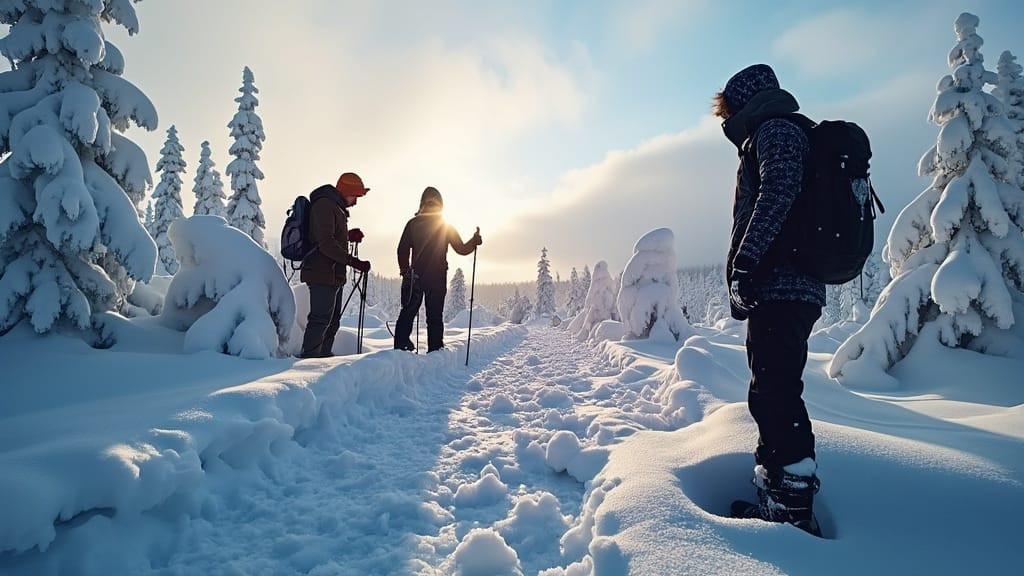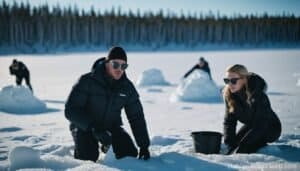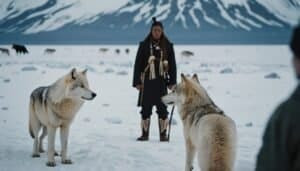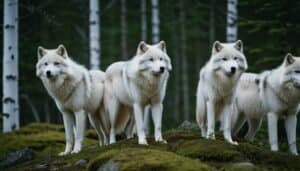Introduction
Arctic wolf conservation is a critical issue that extends beyond national borders, requiring concerted international cooperation
This article explores the multifaceted role of global partnerships in protecting these majestic creatures. From the impact of international treaties and the Arctic Council’s initiatives to the contributions of NGOs and funding mechanisms, each aspect plays a crucial role
We delve into the primary threats facing Arctic wolves, the significant research efforts, and successful case studies of conservation. Additionally, the involvement of local communities, the challenges faced, and the importance of cross-border protected areas and international policies are examined
Finally, we discuss how these conservation efforts align with global environmental goals, highlighting the importance of a unified approach in preserving Arctic biodiversity
International Treaties and Arctic Wolf Conservation
International treaties and agreements are pivotal in the conservation of Arctic wolves, creating a framework for cooperation and shared responsibility among nations
These treaties address various aspects of wildlife protection, habitat preservation, and sustainable development, making them indispensable for effective conservation efforts
Impact of Key International Treaties
Several key international treaties have significantly impacted Arctic wolf conservation
The Convention on International Trade in Endangered Species of Wild Fauna and Flora (CITES) is one such treaty, which regulates international trade in endangered species, including the Arctic wolf, to ensure that it does not threaten their survival. By controlling and monitoring trade, CITES helps prevent illegal activities that could further endanger these wolves
Another important treaty is the Convention on Biological Diversity (CBD). The CBD aims to conserve biodiversity, promote sustainable use of its components, and ensure fair and equitable sharing of benefits arising from genetic resources. Arctic wolves benefit from the CBD’s comprehensive approach to biodiversity conservation, which includes habitat protection and restoration efforts that are crucial for their survival
The Agreement on the Conservation of Polar Bears, which indirectly benefits Arctic wolves, is also noteworthy
This agreement, signed by the five polar bear range states (Canada, Denmark (Greenland), Norway, Russia, and the United States), focuses on protecting polar bear habitats, which are also home to Arctic wolves. By ensuring the preservation of these shared habitats, the agreement contributes to the overall well-being of Arctic wolves
Global Agreements and Their Implementation
Global agreements, such as the Paris Agreement on climate change, play a critical role in addressing the broader environmental issues that impact Arctic wolf conservation
Climate change poses a significant threat to the Arctic ecosystem, affecting prey availability and habitat stability for Arctic wolves. The Paris Agreement’s goal to limit global temperature rise to below 2 degrees Celsius above pre-industrial levels is vital for maintaining the Arctic environment
The implementation of these agreements often involves cooperation between multiple countries and organizations. For instance, the Arctic Council, an intergovernmental forum comprising Arctic states and indigenous communities, facilitates collaboration on environmental protection and sustainable development in the Arctic region
The council’s initiatives, such as the Arctic Monitoring and Assessment Programme (AMAP), provide valuable data and recommendations for addressing climate change and its effects on Arctic wildlife, including wolves
The Arctic Council’s Role in Wolf Conservation
The Arctic Council plays a significant role in Arctic wolf conservation by promoting sustainable development and environmental protection in the Arctic
One of its key initiatives is the Conservation of Arctic Flora and Fauna (CAFF) working group, which focuses on biodiversity conservation and the sustainable use of living resources in the Arctic
CAFF’s Arctic Biodiversity Assessment provides a comprehensive overview of the status and trends of Arctic biodiversity, including Arctic wolves. The assessment highlights the importance of maintaining healthy ecosystems and the need for international cooperation to address the challenges faced by Arctic wildlife
Furthermore, the Arctic Council’s Sustainable Development Working Group (SDWG) supports projects that promote the sustainable use of natural resources and enhance the resilience of Arctic communities. By fostering collaboration among member states and indigenous peoples, the SDWG contributes to the holistic conservation of Arctic wolves and their habitats
International Wildlife Laws Protecting Arctic Wolves
International wildlife laws play a crucial role in protecting Arctic wolves by establishing legal frameworks for conservation efforts
The Endangered Species Act (ESA) of the United States, for example, provides legal protection for endangered and threatened species, including the Arctic wolf. Under the ESA, it is illegal to harm, harass, or kill protected species, and critical habitats are designated to ensure their survival
Similarly, the European Union’s Habitats Directive aims to promote the maintenance of biodiversity by requiring member states to protect natural habitats and wild species. This directive includes provisions for the conservation of species like the Arctic wolf, ensuring that their habitats are safeguarded and restored
These laws are enforced through various means, including fines, sanctions, and international cooperation
For instance, INTERPOL’s Environmental Crime Programme helps combat wildlife crime by coordinating efforts among member countries to detect and prosecute illegal activities that threaten endangered species like the Arctic wolf
Primary Threats to Arctic Wolves Requiring International Attention
Arctic wolves face a variety of threats that necessitate international collaboration to effectively address. These threats are primarily linked to environmental changes and human activities that impact their habitat and food sources
Climate Change and Habitat Loss
Climate change is a major threat to Arctic wolves, significantly altering their environment. Rising temperatures lead to melting ice and permafrost, disrupting the delicate balance of the Arctic ecosystem. This not only affects the wolves directly but also impacts the availability of their prey, such as caribou and muskoxen
A study published in Nature Climate Change (2018) highlights how the Arctic is warming at twice the rate of the global average, a phenomenon known as Arctic amplification. This rapid warming leads to habitat fragmentation, making it difficult for Arctic wolves to find consistent food sources and suitable denning sites
The loss of sea ice also affects the migratory patterns of prey species. For example, caribou migration routes can shift due to changing ice conditions, making it harder for wolves to track and hunt them
Additionally, the timing of snowmelt and freeze-up can impact the availability of prey, as certain species rely on these seasonal changes for their reproductive cycles
Human Activities and Their Impacts
Human activities, such as industrial development, resource extraction, and increased Arctic shipping, pose significant threats to Arctic wolves. The expansion of oil and gas exploration in the Arctic leads to habitat destruction and increased human-wildlife conflicts
For instance, the construction of roads and pipelines fragments the wolves’ habitat, restricting their movement and access to hunting grounds. A report by the World Wildlife Fund (WWF) in 2019 emphasized the negative impact of industrial activities on Arctic wildlife, including increased noise pollution, which can disturb wolf packs and disrupt their natural behaviors
In addition to habitat destruction, human presence in the Arctic increases the risk of direct conflicts between wolves and humans
As more people venture into Arctic regions for tourism or work, the likelihood of encounters with wolves rises. These encounters can result in wolves being killed in self-defense or preemptive measures taken to protect human activities
Furthermore, the increased shipping traffic in the Arctic due to melting ice opens new routes that were previously inaccessible. This not only increases the risk of oil spills and pollution but also disrupts the natural habitat of Arctic wolves. Marine pollution from ships can contaminate the food chain, affecting both the wolves and their prey
Role of NGOs and Funding Mechanisms in International Conservation
Non-governmental organizations (NGOs) and funding mechanisms play a crucial role in the conservation of Arctic wolves. They provide resources, expertise, and advocacy necessary to implement conservation strategies and raise awareness about the threats faced by these animals
Contributions of Major NGOs
Major NGOs such as the World Wildlife Fund (WWF), Wildlife Conservation Society (WCS), and Greenpeace have been instrumental in Arctic wolf conservation. These organizations conduct research, promote sustainable practices, and engage in advocacy efforts to influence policy decisions
The WWF, for example, has launched initiatives focused on protecting Arctic habitats and mitigating the impacts of climate change
Their Arctic Program works on preserving critical areas and supporting indigenous communities whose traditional knowledge contributes to conservation efforts. The WWF’s reports and campaigns help raise global awareness about the plight of Arctic wolves and the urgent need for action
The WCS has been involved in Arctic research for decades, providing valuable data on wolf populations and their ecological roles. Their field studies help identify critical habitats and inform management practices. By collaborating with local governments and other stakeholders, the WCS ensures that conservation strategies are scientifically sound and culturally appropriate
Greenpeace, known for its environmental activism, has also been active in the Arctic region. Their campaigns against oil drilling and industrial activities highlight the broader environmental impacts that threaten Arctic wildlife, including wolves
By mobilizing public support and pressuring governments, Greenpeace aims to protect the Arctic from unsustainable exploitation
Collaborative Efforts and Initiatives
Collaboration among NGOs, governments, and local communities is essential for successful Arctic wolf conservation. Joint initiatives, such as the Arctic Council’s Conservation of Arctic Flora and Fauna (CAFF) working group, bring together various stakeholders to address conservation challenges collectively
One notable example of collaborative efforts is the Circumpolar Biodiversity Monitoring Program (CBMP), which involves multiple countries and organizations working together to monitor and assess Arctic biodiversity
This program provides a comprehensive understanding of the status and trends of Arctic species, including wolves, enabling informed decision-making and adaptive management strategies
Another important initiative is the Indigenous Knowledge and Western Science (IKWS) approach, which integrates traditional knowledge of indigenous peoples with scientific research. This approach enhances conservation efforts by incorporating local perspectives and expertise, ensuring that strategies are culturally relevant and effective
These collaborative efforts often lead to the development of action plans and conservation strategies that are implemented at both regional and international levels. By pooling resources and expertise, stakeholders can address the complex challenges of Arctic wolf conservation more effectively
Governmental and Intergovernmental Funding
Adequate funding is crucial for the implementation of conservation programs. Governments and intergovernmental organizations provide significant financial support for Arctic wolf conservation through grants, subsidies, and international funding mechanisms
The Global Environment Facility (GEF), for instance, funds projects that address biodiversity loss and climate change impacts in the Arctic. By supporting initiatives that protect critical habitats and promote sustainable development, the GEF contributes to the conservation of Arctic wolves and their ecosystems
National governments also allocate funds for wildlife conservation through agencies such as the U.S. Fish and Wildlife Service and Environment and Climate Change Canada. These agencies implement programs that protect endangered species, restore habitats, and support research efforts
Additionally, bilateral agreements between countries often include provisions for funding joint conservation projects
Private Sector and Philanthropic Contributions
The private sector and philanthropic organizations also play a significant role in funding Arctic wolf conservation. Corporations involved in the Arctic region, such as those in the oil and gas industry, are increasingly recognizing their responsibility to mitigate environmental impacts
Some companies contribute to conservation efforts through corporate social responsibility (CSR) initiatives, funding habitat restoration projects, and supporting research
Philanthropic foundations, such as the Gordon and Betty Moore Foundation and the Pew Charitable Trusts, provide grants to NGOs and research institutions working on Arctic conservation. These foundations focus on long-term solutions and support projects that address the root causes of biodiversity loss
International Research and Successful Case Studies
Research plays a critical role in understanding Arctic wolf ecology, behavior, and the challenges they face. Successful conservation efforts often rely on comprehensive data gathered through international research collaborations, which inform management strategies and policies
Key Research Projects and Findings
Several key research projects have provided valuable insights into the lives of Arctic wolves and the factors affecting their survival
One such project is the Arctic Wolf Project, led by biologist David Mech, which has been studying the wolves on Ellesmere Island in Canada since the 1980s. This long-term study has documented the wolves’ social structures, hunting behaviors, and interactions with their prey, contributing significantly to our understanding of Arctic wolf ecology
Another important research initiative is the Arctic Predator Project, which involves scientists from various countries studying the interactions between Arctic predators, including wolves, and their prey. This project focuses on understanding the effects of climate change on predator-prey dynamics, providing critical data on how changing ice conditions and prey availability impact wolf populations
Research conducted by the University of Alaska Fairbanks has also shed light on the genetic diversity of Arctic wolves
Studies have shown that genetic diversity is crucial for the resilience of wolf populations, allowing them to adapt to environmental changes and disease threats. By analyzing genetic samples, researchers can identify distinct populations and prioritize conservation efforts to maintain their genetic health
Contributions of Global Research Institutions
Global research institutions play a pivotal role in advancing our knowledge of Arctic wolves. The International Arctic Research Center (IARC) in Alaska, for example, conducts multidisciplinary research on Arctic climate, ecosystems, and wildlife. Their findings contribute to global understanding of Arctic changes and inform conservation strategies
The Polar Research Institute of China (PRIC) collaborates with international partners to study the Arctic environment, including the impacts of climate change on its biodiversity. By sharing data and expertise, PRIC enhances global efforts to protect Arctic wildlife, including wolves
European research institutions, such as the Norwegian Polar Institute and the Arctic Centre at the University of Lapland, also contribute significantly to Arctic wolf research. These institutions focus on various aspects of Arctic ecology and collaborate with researchers worldwide to address conservation challenges
Notable Success Stories
There are several notable success stories in Arctic wolf conservation that highlight the importance of international cooperation. One such example is the establishment of protected areas that span multiple countries, ensuring the preservation of critical habitats for Arctic wolves
The creation of the Arctic National Wildlife Refuge (ANWR) in the United States and the adjacent Ivvavik and Vuntut National Parks in Canada is a prime example of cross-border collaboration
These protected areas provide a vast, contiguous habitat for Arctic wolves and other wildlife, allowing for natural migration and reducing human-wildlife conflicts
In Greenland, the establishment of the Northeast Greenland National Park, the largest national park in the world, has been instrumental in protecting the habitat of Arctic wolves. This park, covering 972,000 square kilometers, offers a refuge for wolves and other Arctic species, safeguarding them from industrial activities and habitat destruction
Lessons Learned and Best Practices
Successful Arctic wolf conservation efforts offer valuable lessons and best practices that can be applied to future projects
One key lesson is the importance of involving local communities and indigenous peoples in conservation initiatives. Their traditional knowledge and close relationship with the land provide critical insights and foster a sense of stewardship
Adaptive management is another best practice, allowing conservation strategies to be flexible and responsive to changing conditions. For example, incorporating real-time data on climate and wildlife movements enables managers to adjust their approaches as needed, improving the effectiveness of conservation efforts
International collaboration and information sharing are also crucial for success
By pooling resources, expertise, and data, countries and organizations can address the complex challenges of Arctic wolf conservation more effectively. Joint monitoring programs, standardized data collection methods, and shared research findings enhance global understanding and facilitate coordinated action
Local Communities and Challenges in Conservation Projects
Local communities, particularly indigenous peoples, play a vital role in Arctic wolf conservation. Their involvement ensures that conservation efforts are culturally appropriate and sustainable, benefiting both wildlife and human populations
Benefits to Local Communities
Conservation projects often provide tangible benefits to local communities, such as job opportunities, improved livelihoods, and enhanced ecosystem services
For example, ecotourism initiatives that promote Arctic wolf viewing can generate income for local residents, supporting economic development while raising awareness about wildlife conservation
Involving local communities in conservation efforts also fosters a sense of ownership and responsibility. Community-led monitoring programs enable residents to actively participate in tracking wildlife populations and reporting threats, contributing valuable data for conservation planning
Additionally, the preservation of traditional knowledge and cultural practices related to Arctic wolves can strengthen community identity and resilience. Indigenous knowledge often includes detailed understanding of wildlife behavior, migration patterns, and habitat use, which can complement scientific research and enhance conservation outcomes
Involvement of Indigenous Peoples
Indigenous peoples have a deep connection to the Arctic environment and its wildlife, making their involvement in conservation efforts essential
Co-management agreements, such as those established in Canada and Alaska, provide a framework for collaborative decision-making between indigenous communities and government agencies
These agreements ensure that indigenous perspectives and traditional knowledge are integrated into wildlife management plans, promoting sustainable practices and respecting cultural values. For example, the Inuvialuit Final Agreement in Canada includes provisions for the co-management of wildlife and the protection of indigenous hunting rights, balancing conservation goals with traditional livelihoods
The Arctic Council’s Permanent Participants, which include indigenous organizations from across the Arctic, play a key role in advocating for the rights and interests of indigenous peoples in conservation discussions. Their participation ensures that indigenous voices are heard and that conservation policies are inclusive and equitable
Political and Economic Barriers
Conservation projects in the Arctic often face significant political and economic barriers. Political instability, conflicting interests, and limited resources can hinder the implementation of effective conservation strategies
For instance, geopolitical tensions in the Arctic region can complicate international cooperation and impede joint conservation efforts. Disputes over territorial claims, resource exploitation, and navigation rights can create obstacles to establishing protected areas and enforcing wildlife protection laws
Economic considerations also pose challenges. The Arctic is rich in natural resources, and economic interests in oil, gas, and mineral extraction often conflict with conservation goals. Balancing the need for economic development with the imperative to protect Arctic ecosystems requires careful negotiation and compromise
Logistical and Environmental Challenges
The harsh and remote environment of the Arctic presents logistical challenges for conservation projects. Extreme weather conditions, difficult terrain, and limited infrastructure make it challenging to conduct field research, monitor wildlife populations, and implement management actions
Seasonal variations in daylight, temperature, and ice conditions also affect the feasibility and timing of conservation activities. For example, conducting aerial surveys or deploying tracking devices on wolves may only be possible during certain times of the year when weather conditions are favorable
Environmental challenges, such as the unpredictability of climate change impacts, add another layer of complexity. Rapid changes in sea ice extent, permafrost thaw, and vegetation cover require adaptive management strategies that can respond to evolving conditions
Despite these challenges, the collaboration of local communities, governments, and international partners can overcome barriers and ensure the successful conservation of Arctic wolves. By addressing political, economic, and logistical challenges through innovative approaches and cooperative efforts, conservation projects can make a lasting impact on the survival of these iconic predators
Cross-Border Protected Areas and International Policies
Cross-border protected areas and international policies are crucial components of Arctic wolf conservation. They provide a unified approach to habitat preservation and ensure that conservation efforts are coordinated across national boundaries
Establishment and Management
The establishment and management of cross-border protected areas are essential for providing continuous habitats for Arctic wolves. These areas help mitigate the impacts of habitat fragmentation and allow for the natural movement of wolf populations across vast territories
One prominent example is the Yukon-Charley Rivers National Preserve in the United States, which connects to Canada’s Ivvavik National Park
This transboundary protected area supports a variety of Arctic wildlife, including wolves, by maintaining large, contiguous tracts of wilderness. Joint management efforts between the U.S. National Park Service and Parks Canada ensure that conservation measures are harmonized across the border
Similarly, the Beringia International Park, proposed by Russia and the United States, aims to protect the ecological corridor between Alaska and Siberia. This area is crucial for the migration and genetic diversity of Arctic species, including wolves. The collaboration between both countries enhances the effectiveness of conservation actions and promotes the sharing of resources and expertise
The management of these cross-border areas involves regular communication and coordination between the respective countries’ wildlife agencies. They work together to monitor wildlife populations, enforce regulations, and implement conservation strategies that address the unique challenges of the Arctic environment
Benefits and Challenges
Cross-border protected areas offer numerous benefits for Arctic wolf conservation
They provide large, interconnected habitats that support the wolves’ need for vast territories to hunt and breed. By preserving these areas, countries can ensure the long-term survival of wolf populations and maintain the ecological integrity of the Arctic
These areas also facilitate scientific research and monitoring by providing a more comprehensive understanding of wolf movements and behaviors. Researchers can study how wolves use the landscape across different regions, gaining insights that inform conservation strategies on a broader scale
However, the establishment and management of cross-border protected areas also present challenges. Political and logistical issues, such as differing conservation priorities, regulatory frameworks, and funding mechanisms, can complicate the coordination between countries. Ensuring consistent enforcement of protection measures and addressing potential conflicts requires strong international cooperation and diplomacy
Environmental challenges, such as climate change, further complicate the management of these areas. Changes in sea ice, vegetation, and prey availability can alter the suitability of habitats, necessitating adaptive management approaches that can respond to these dynamic conditions
Conservation Policies and Their Effects
International conservation policies play a significant role in protecting Arctic wolves by establishing legal frameworks and guiding conservation efforts
Policies such as the United Nations Convention on Biological Diversity (CBD) and the Convention on Migratory Species (CMS) provide a foundation for international cooperation and action
The CBD promotes the conservation of biological diversity, the sustainable use of its components, and the fair and equitable sharing of benefits arising from genetic resources. By encouraging countries to develop and implement national biodiversity strategies, the CBD supports the protection of Arctic wolf habitats and the maintenance of ecological processes essential for their survival
The CMS, also known as the Bonn Convention, focuses on the conservation of migratory species and their habitats
Arctic wolves, which may migrate across national boundaries in search of food and breeding grounds, benefit from the protection measures outlined in the CMS. This convention facilitates international collaboration to ensure that migratory species have access to safe and suitable habitats throughout their range
International policies also promote the creation of protected areas, the regulation of trade in endangered species, and the management of human activities that impact wildlife. These policies provide a framework for countries to harmonize their conservation efforts and address the transboundary nature of Arctic wolf conservation
Broader Implications for Arctic Ecosystems
The conservation of Arctic wolves has broader implications for the health and resilience of Arctic ecosystems. As apex predators, wolves play a crucial role in maintaining the balance of their ecosystems. They regulate prey populations, which in turn affects vegetation and other wildlife species
For example, studies have shown that the presence of wolves can influence the behavior and distribution of herbivores like caribou and muskoxen. By controlling herbivore numbers, wolves help prevent overgrazing and promote the regeneration of vegetation. This, in turn, supports a diverse array of plant and animal species, contributing to the overall biodiversity and stability of the ecosystem
Protecting Arctic wolves also involves preserving the habitats and ecological processes they depend on
This includes safeguarding wetlands, tundra, and coastal areas that provide critical resources for wolves and other wildlife. By focusing on the conservation of these habitats, countries can enhance the resilience of Arctic ecosystems to climate change and other environmental pressures
The interconnected nature of Arctic ecosystems means that conservation efforts for wolves can have cascading effects throughout the food web. By ensuring the survival of this key predator, countries can support the broader goal of maintaining healthy and functioning Arctic ecosystems
Alignment with Global Environmental Goals
Arctic wolf conservation efforts align with broader global environmental goals, emphasizing the interconnectedness of biodiversity conservation, climate action, and sustainable development
Integration with UN Sustainable Development Goals
The United Nations Sustainable Development Goals (SDGs) provide a global framework for addressing a wide range of social, economic, and environmental challenges
Arctic wolf conservation aligns with several SDGs, highlighting the importance of preserving biodiversity and promoting sustainable practices:
Goal 13: Climate Action is directly relevant to Arctic wolf conservation. By addressing the impacts of climate change on Arctic ecosystems, countries contribute to the resilience of these environments and the species that inhabit them
Conservation efforts that mitigate climate change, such as reducing greenhouse gas emissions and protecting carbon sinks, support the broader goal of combating global warming
Goal 15: Life on Land focuses on the protection, restoration, and sustainable use of terrestrial ecosystems
Arctic wolf conservation directly contributes to this goal by safeguarding critical habitats, promoting biodiversity, and ensuring the sustainable management of natural resources. By maintaining healthy ecosystems, countries support the well-being of both wildlife and human communities
Goal 17: Partnerships for the Goals emphasizes the importance of international collaboration and cooperation in achieving sustainable development
The transboundary nature of Arctic wolf conservation requires strong partnerships between countries, NGOs, indigenous peoples, and other stakeholders. By working together, these groups can effectively address the challenges facing Arctic wolves and contribute to global environmental goals
Global Environmental Strategies
Global environmental strategies, such as the Paris Agreement on climate change and the Aichi Biodiversity Targets, provide a roadmap for addressing environmental challenges and promoting sustainable development. Arctic wolf conservation efforts contribute to these strategies by addressing key threats and promoting the protection of critical habitats
The Paris Agreement aims to limit global temperature rise to below 2 degrees Celsius above pre-industrial levels, with efforts to limit the increase to 1.5 degrees Celsius
Protecting Arctic ecosystems, which are particularly vulnerable to climate change, is essential for achieving these targets. Conservation efforts that reduce greenhouse gas emissions and enhance the resilience of Arctic habitats support the broader goals of the Paris Agreement
The Aichi Biodiversity Targets, established under the CBD, outline specific goals for conserving biodiversity and ensuring the sustainable use of biological resources
Arctic wolf conservation aligns with several of these targets, including Target 5 (reducing the loss of natural habitats), Target 11 (protecting at least 17% of terrestrial and inland water areas), and Target 12 (preventing the extinction of known threatened species)
By aligning Arctic wolf conservation with global environmental strategies, countries can enhance the effectiveness of their efforts and contribute to broader international goals. This integrated approach ensures that conservation actions are part of a cohesive and coordinated global response to environmental challenges
Conclusion
International cooperation plays a pivotal role in the conservation of Arctic wolves, addressing complex challenges that transcend national boundaries
From the implementation of key international treaties and the establishment of cross-border protected areas to the contributions of NGOs and the integration of indigenous knowledge, global partnerships are essential for effective conservation efforts
Climate change and human activities present significant threats to Arctic wolves, necessitating a coordinated response that includes scientific research, policy enforcement, and adaptive management strategies. Successful case studies and collaborative initiatives demonstrate the power of collective action, highlighting the importance of involving local communities and leveraging diverse funding sources
The Arctic Council, along with various international wildlife laws, provides a framework for protecting Arctic wolves and their habitats
These efforts align with global environmental goals, such as the UN Sustainable Development Goals and the Paris Agreement, underscoring the interconnectedness of biodiversity conservation, climate action, and sustainable development
By continuing to foster international collaboration and implementing comprehensive conservation strategies, we can ensure the survival of Arctic wolves and preserve the unique biodiversity of the Arctic region for future generations. The ongoing commitment of countries, organizations, and communities around the world is crucial for maintaining the health and resilience of Arctic ecosystems in the face of unprecedented environmental change










